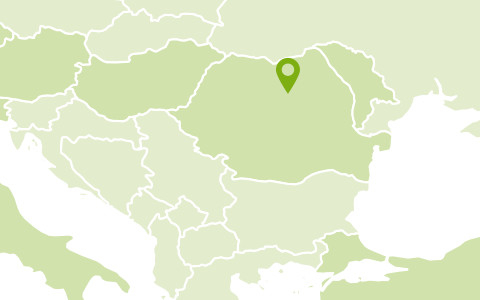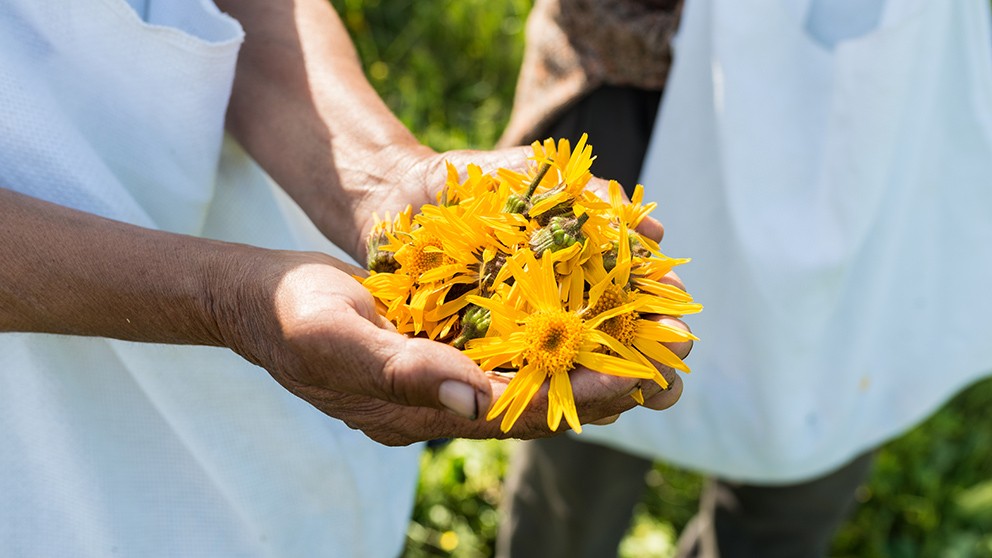Arnica
Carpathian Mountains, Romania

Budding Prospects
Biodiversity. When the small medicinal plant arnica blooms, Marinella is so excited she can hardly sleep. After all, the harvest is a momentous occasion when everyone returns to their villages in the remote Apuseni Mountains in the Carpathians.
With bells ringing, a wooden horse-drawn wagon rumbles around the corner. On the bed of this simple carriage, heavy logs have been tied down with a few ropes. The wagon slowly rolls past simple, grey wooden houses and villagers who are raking hay into large piles. When the wagon stops, people take a break and have a chat.
It has only been two years now that a paved road leads to Ghetar, the village where Florin Pacurar lives during the summer. The 38-year-old teaches grassland management at the University of Cluj-Napoca and heads the Ecoflora project, which studies the plants in the region and seeks to conserve the use of medicinal plants as a valuable natural resource in Romania. He came here nearly 15 years ago to complete his final dissertation. Today, he owns two wooden houses where staff members and students live during the arnica season.
Arnica could be the saving grace for local people
Before the project building awaits a group of students who have attended Florin’s seminar at the university. As they stroll towards the house, the professor tells the students about the meadow plants. The most important plant for the locals blooms with bright yellow flowers and forms green rosettes out of its leaves at ground level: Arnica montana. Its healing properties make it a prized ingredient in traditional remedies. In the Apuseni Mountains, arnica also helps combat the people’s poverty – and the locals help ensure arnica’s survival.
Large quantities of wild arnica grow on the gentle knolls and slopes of the Romanian Carpathians, which include the Apuseni Mountains. But the plant is highly sensitive. If too many cows graze on the meadows or the farmers use chemical fertilisers, the arnica immediately reacts to the changed soil conditions and disappears. It is extremely fickle and only thrives on predominantly natural meadows. Although it is possible to cultivate arnica, it is difficult to grow, and to conserve biodiversity and natural conditions in the region, it is essential to gather plants in the wild.

Is there any work for my son yet?
“We want to create a model so people in the region can see what is possible,” says Florin. Cheap labour and inexpensive raw ingredients should not be the main incentives, but rather sustainable use, fair working conditions and quality. Florin insists on maintaining good agricultural and collection practices, which stipulate how wild plants can be sustainably harvested and processed to acquire a high-quality product.
To help achieve these goals, Florin and his German colleague conduct training sessions every year with local pickers. A brochure with simple illustrations shows the ideal method for sustainably harvesting arnica.
Many people return to the villages to help with the arnica harvest. They spend the summer working on the high pastures and living in simple huts. When Florin drives by on the plateau of Calineasa, they sometimes waive him over. “Is there any work for my son yet?”, asks an elderly woman standing by a fence. “We’ll start over the coming days,” replies Florin. The people here have recognised the value of nature.
When they start picking, it soon becomes apparent that everyone has their own technique. For instance, Marinella Negrea uses her thumb and index finger to pinch off the blossom heads. She works quickly and uses both hands at the same time. “When I know that the arnica is in bloom, I’m so excited I can hardly sleep,” says Marinella. Her life story is typical for the region. She dropped out of school at the age of 14 and married at the age of 17. Today, Marinella is 32 years old and has a 13-year-old daughter. “I want my daughter to attend university so she manages to get out of here.”
Helping people and nature
As the sun disappears behind the tops of the spruce trees, work begins in the project house. Florin’s students are helping to process the arnica. One of them empties a bag of blossoms on a table with a metal surface, and they all sort out small stones and unsuitable flowers. The clean blossoms are spread on tightly woven nets that are stacked on top of each other in the dryer.
The harvest has begun and this means that for Florin and his coworkers the coming weeks will be exhausting, as they work from dawn to dusk. But it also means that their concept works: the sustainable collection of wild plants that helps people and nature. It is already a challenge to convince young people in the area that there is a future for them here. What’s more, it will become increasingly important to preserve arnica’s natural habitat with the right initiatives. But if people believe in the budding prospects for the future with these yellow arnica blossoms that abound in the meadows this year, then there is little reason for concern.

